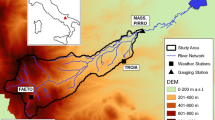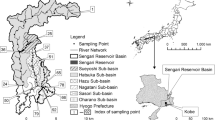Abstract
Reservoirs in Taiwan are inundated with nutrients that result in algal growth, and thus also reservoir eutrophication. Controlling the phosphorus load has always been the most crucial issue for maintaining reservoir water quality. Numerous agricultural activities, especially the production of tea in riparian areas, are conducted in watersheds in Taiwan. Nutrients from such activities, including phosphorus, are typically flushed into rivers during flooding, when over 90 % of the yearly total amount of phosphorous enters reservoirs. Excessive or enhanced soil erosion from rainstorms can dramatically increase the river sediment load and the amount of particulate phosphorus flushed into rivers. When flow rates are high, particulate phosphorus is the dominant form of phosphorus, but sediment and discharge measurements are difficult during flooding, which makes estimating phosphorus flux in rivers difficult. This study determines total amounts of phosphorus transport by measuring flood discharge and phosphorous levels during flooding. Changes in particulate phosphorus, dissolved phosphorus, and their adsorption behavior during a 24-h period are analyzed owing to the fact that the time for particulate phosphorus adsorption and desorption approaching equilibrium is about 16 h. Erosion of the reservoir watershed was caused by adsorption and desorption of suspended solids in the river, a process which can be summarily described using the Lagmuir isotherm. A method for estimating the phosphorus flux in the Daiyujay Creek during Typhoon Bilis in 2006 is presented in this study. Both sediment and phosphorus are affected by the drastic discharge during flooding. Water quality data were collected during two flood events, flood in June 9, 2006 and Typhoon Bilis, to show the concentrations of suspended solids and total phosphorus during floods are much higher than normal stages. Therefore, the drastic changes of total phosphorus, particulate phosphorus, and dissolved phosphorus in rivers during flooding should be monitored to evaluate the loading of phosphorus more precisely. The results show that monitoring and controlling phosphorus transport during flooding can help prevent the eutrophication of a reservoir.













Similar content being viewed by others
References
Beauchemin, S., Simard, R. R., & Cluis, D. (1996). Phosphorus sorption–desorption kinetics of soil under contrasting land uses. Journal of Environmental Quality, 25(6), 1317–1325.
Bowes, M. J., House, W. A., Hodgkinson, R. A., & Leach, D. V. (2005). Phosphorus—discharge hysteresis during storm events along a river catchment: the River Swale, UK. Water Research, 39(5), 751–762.
Bowes, M. J., Smith, J. T., Jarvie, H. P., & Neal, C. (2008). Modelling of phosphorus inputs to rivers from diffuse and point sources. Science of the Total Environment, 395(2-3), 125–138.
Chapra, S. C. (1997). Surface water—quality modeling. New York: McGraw-Hill.
Furumai, H., & Ohgaki, S. (1989). Adsorption–desorption of phosphorus by lake sediments under anaerobic conditions. Water Research, 23(6), 677–683.
Harter, C. D. (1968). Adsorption of phosphorus by lake sediment. Soil Science Society of America Proceedings, 32(4), 514–518.
Hatch, L. K., Reuter, J. E., & Goldman, C. R. (1999). Daily phosphorus variation in a mountain stream. Water Resources Research, 35(12), 3783–3791.
Hilton, J., Buckland, P., & Irons, G. P. (2002). An assessment of a simple method for estimating the relative contributions of point and diffuse source phosphorus to in-river phosphorus loads. Hydrobiologia, 472(1–3), 77–83.
House, W. A., Denison, F. H., Smith, J. T., & Armitage, P. D. (1995). An investigation of the effects of water velocity on inorganic phosphorus influx to a sediment. Environmental Pollution, 89(3), 263–271.
Kronvang, B. (1992). The export of particulate matter, particulate phosphorus and dissolved phosphorus and dissolved phosphorus from two agriculture river basins: implications on estimating the non-point phosphorus load. Water Research, 26(10), 1347–1358.
Ku, W. C., DiGiano, F. A., & Feng, T. H. (1978). Factors affecting phosphate adsorption equilibria in lake sediments. Water Research, 12(12), 1069–1074.
Langmuir, I. (1916). The constitution and fundamental properties of solids and liquids. Part I. Solids. Journal of the American Chemical Society, 38(11), 2221–2295.
Nash, D. M., & Halliwell, D. J. (2000). Tracing phosphorus transferred from grazing land to water. Water Research, 34(7), 1975–1985.
Pan, G., Krom, M. D., & Herut, B. (2002). Adsorption–desorption of phosphate on airborne dust and riverborne particulates in East Mediterranean Seawater. Environmental Science and Technology, 36(16), 3519–3524.
Pionke, H. B., Gburek, A. N., Sharpley, A. N., & Schnabel, R. R. (1996). Flow and nutrient export patterns for an agricultural hill-land watershed. Water Resources Research, 32(6), 1795–1804.
Reddy, K. R., Flaig, E., Scinto, L. J., Diaz, O., & DeBusk, T. A. (1996). Phosphorus assimilation in a stream system of the Lake Okeechobee basin. Water Resources Bulletin, 32(5), 901–915.
Sharpley, A. N., & Syers, J. K. (1979). Phosphorus inputs into a stream draining an agricultural watershed, II, amounts contributed and relative significance of runoff types. Water, Air, and Soil Pollution, 11(4), 417–428.
Taipei Water Management Office. (2006). Assimilative capacity estimation for the catchment protected by the Taipei Water Management Office. Taipei: Ministry of Economic Affairs.
Taipei Water Management Office (2012). Taipei Water Management Office, WRA homepage. http://www.wratb.gov.tw/mp.asp?mp=11E Accessed 09 Sept. 2012.
Taiwan Environmental Protection Administration. (2006). The program for reduction of pollution sources in Fei-Tsuei Reservoir watershed. Taipei: Executive Yuan.
Unsitalo, R., Yli-Halla, M., & Turtola, E. (2000). Suspended solid as a source of potentially bioavailable phosphorus in surface runoff waters from clay soils. Water Research, 34(9), 2477–2482.
Williams, J. D. H., Syers, J. K., Harris, R. F., & Armstrong, D. E. (1970). Adsorption and desorption of inorganic phosphorus by lake sediments in a 0.1 M NaCl system. Environmental Science and Technology, 4(6), 517–519.
Acknowledgments
The authors are thankful to anonymous reviewers for their simulating comments and suggestions. This paper is based on a work partially supported by the Taipei Water Management Office, Water Resources Agency of Taiwan.
Author information
Authors and Affiliations
Corresponding author
Rights and permissions
About this article
Cite this article
Chen, YC., Liu, JH., Kuo, JT. et al. Estimation of phosphorus flux in rivers during flooding. Environ Monit Assess 185, 5653–5672 (2013). https://doi.org/10.1007/s10661-012-2974-5
Received:
Accepted:
Published:
Issue Date:
DOI: https://doi.org/10.1007/s10661-012-2974-5




